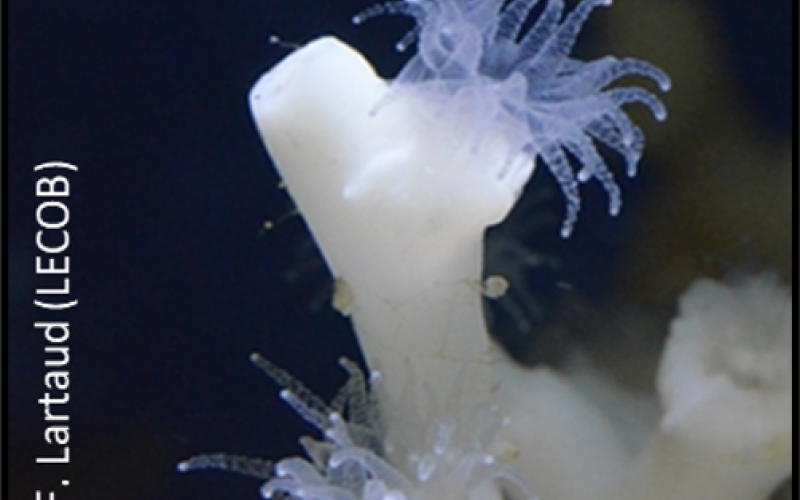
General topics
The Effects of Global Changes on the Physiology and Microbiome of Cold-Water Corals in the Lampaul Canyon
Like their tropical analogous, cold-water colonial corals are engineer species which create complex habitats among the richest in deep-sea biodiversity (Rogers. 1999). Although living in deeper waters than tropical corals (from 5 m to over 3,000 m depth), cold-water corals are already facing the impacts of trawling and land-based pollution, and will also rapidly face the cumulative threats of ocean warming and acidification (Foley et al. 2010). Furthermore, due to the difficulty of deep-sea sampling, detailed knowledge of the ecology and physiology of cold-water corals is still lacking compared to their tropical counterparts, particularly on the specific host-bacteria associations recently highlighted (Neulinger et al. 2008, Meistertzheim et al. 2016, Kellog et al. 2017).
This thesis is part of the ARDECO (Assessing Resilience of DEep COrals) ANR project. It aims to study the impact of global warming and ocean acidification on the microbiome and its role in the physiology of 3 cold-water coral species present in the Lampaul Canyon: Madrepora oculata, Desmophylum pertusum and Solenosmilia variabilis.
Pressurized aquariums specially dedicated to the long-term maintenance of cold corals and designed for the ARDECO project will enable us to study the impact of warming and acidification on cold corals at their native pressure, which until now has always been studied at atmospheric pressure, despite the importance of this factor on coral physiology.
Several aspects will be addressed on natural populations and after aquarium experimentation: (1) Characterize the microbiome by identifying, locating and quantifying bacteria in the various tissues of the coral host using molecular biology, fluorescence in situ hybridization and electron microscopy approaches, (2) Determine the functional role of the microbiome by searching for bacterial functional genes and studying the interactions between the polyp and its bacteria using molecular biology approaches and incubations with labeled compounds (15N and 13C) and (3) Analyze the evolution of skeletal growth using a chemical labeling technique observed under epifluorescence microscopy.
Bibliographic references
Like their tropical analogous, cold-water colonial corals are engineer species which create complex habitats among the richest in deep-sea biodiversity (Rogers. 1999). Although living in deeper waters than tropical corals (from 5 m to over 3,000 m depth), cold-water corals are already facing the impacts of trawling and land-based pollution, and will also rapidly face the cumulative threats of ocean warming and acidification (Foley et al. 2010). Furthermore, due to the difficulty of deep-sea sampling, detailed knowledge of the ecology and physiology of cold-water corals is still lacking compared to their tropical counterparts, particularly on the specific host-bacteria associations recently highlighted (Neulinger et al. 2008, Meistertzheim et al. 2016, Kellog et al. 2017).
This thesis is part of the ARDECO (Assessing Resilience of DEep COrals) ANR project. It aims to study the impact of global warming and ocean acidification on the microbiome and its role in the physiology of 3 cold-water coral species present in the Lampaul Canyon: Madrepora oculata, Desmophylum pertusum and Solenosmilia variabilis.
Pressurized aquariums specially dedicated to the long-term maintenance of cold corals and designed for the ARDECO project will enable us to study the impact of warming and acidification on cold corals at their native pressure, which until now has always been studied at atmospheric pressure, despite the importance of this factor on coral physiology.
Several aspects will be addressed on natural populations and after aquarium experimentation: (1) Characterize the microbiome by identifying, locating and quantifying bacteria in the various tissues of the coral host using molecular biology, fluorescence in situ hybridization and electron microscopy approaches, (2) Determine the functional role of the microbiome by searching for bacterial functional genes and studying the interactions between the polyp and its bacteria using molecular biology approaches and incubations with labeled compounds (15N and 13C) and (3) Analyze the evolution of skeletal growth using a chemical labeling technique observed under epifluorescence microscopy.
Bibliographic references
- Rogers. 1999. International Review of Hydrobiology 84:315-406
- Foley et al. 2010. Ocean & Coastal Management 53:313-326
- Neulinger et al. 2008. Applied and Environmental Microbiology 75 : 1437-1444
- Meistertzheim et al. 2016. Deep-sea Resaerch I 114 : 12-22
- Kellog et al. 2017. Frontiers in Microbiology 8 : 796
Teaching
Je participe à l'enseignement à Sorbonne Université dans les UE suivantes :
- [LU2SV302] Organisation fonctionnelle des animaux : TP de L2
- [LU3SV602] Biologie comparée et Evolution des animaux : TP de L3


